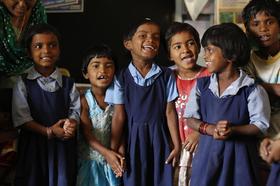For the 2025-26 school year, there is 1 public preschool serving 89 students in Warwick 29 School District. This district's average pre testing ranking is 1/10, which is in the bottom 50% of public pre schools in North Dakota.
Public Preschool in Warwick 29 School District have an average math proficiency score of 20% (versus the North Dakota public pre school average of 42%), and reading proficiency score of 20% (versus the 44% statewide average).
Minority enrollment is 100% of the student body (majority American Indian), which is more than the North Dakota public preschool average of 25% (majority American Indian).
Overview
This School District
This State (ND)
# Schools
3 Schools
178 Schools
# Students
206 Students
32,362 Students
# Teachers
20 Teachers
2,776 Teachers
Student-Teacher Ratio
10:1
10:1
Student By Grade
District Rank
Warwick 29 School District, which is ranked within the bottom 50% of all 164 school districts in North Dakota (based off of combined math and reading proficiency testing data) for the 2021-2022 school year.
The school district's graduation rate of 80% has increased from 40-59% over five school years.
Overall District Rank
#162 out of 167 school districts
(Bottom 50%)
(Bottom 50%)
Math Test Scores (% Proficient)
(21-22)≤5%
39%
Reading/Language Arts Test Scores (% Proficient)
6-9%
44%
Science Test Scores (% Proficient)
11-19%
44%
Graduation Rate
(21-22)≥80%
85%
Students by Ethnicity:
Diversity Score
0.08
0.43
% American Indian
96%
11%
% Asian
2%
1%
% Hispanic
1%
6%
% Black
n/a
3%
% White
n/a
75%
% Hawaiian
n/a
n/a
% Two or more races
1%
4%
All Ethnic Groups
District Revenue and Spending
The revenue/student of $29,495 is higher than the state median of $17,628. The school district revenue/student has grown by 14% over four school years.
The school district's spending/student of $29,160 is higher than the state median of $17,630. The school district spending/student has grown by 14% over four school years.
Total Revenue
$6 MM
$2,154 MM
Spending
$6 MM
$2,154 MM
Revenue / Student
$29,495
$17,628
Spending / Student
$29,160
$17,630
Best Warwick 29 School District Public Preschools (2025-26)
School
(Math and Reading Proficiency)
(Math and Reading Proficiency)
Location
Quick Facts
Rank: #11.
Warwick Elementary School
(Math: ≤20% | Reading: ≤20%)
Rank:
Rank:
1/
Bottom 50%10
210 4th Ave
Warwick, ND 58381
(701) 294-2561
Warwick, ND 58381
(701) 294-2561
Gr: PK-4 | 89 students Student-teacher ratio: 11:1
Recent Articles

How to Pick the Right Public School for Next Semester
A clear, step-by-step guide to choosing the right public school for next semester, including timelines, comparisons, and expert insights.

Hidden Costs of Private School: Fees, Uniforms, Transport and More
Understand the hidden costs of private school in 2025, including uniforms, fees, meals, activities, transport, and technology.

Private vs. Public School: Reality Check- 2025
A 2025 update on private vs. public schools—tuition, enrollment trends, policy shifts, and what parents should consider in today’s landscape.





